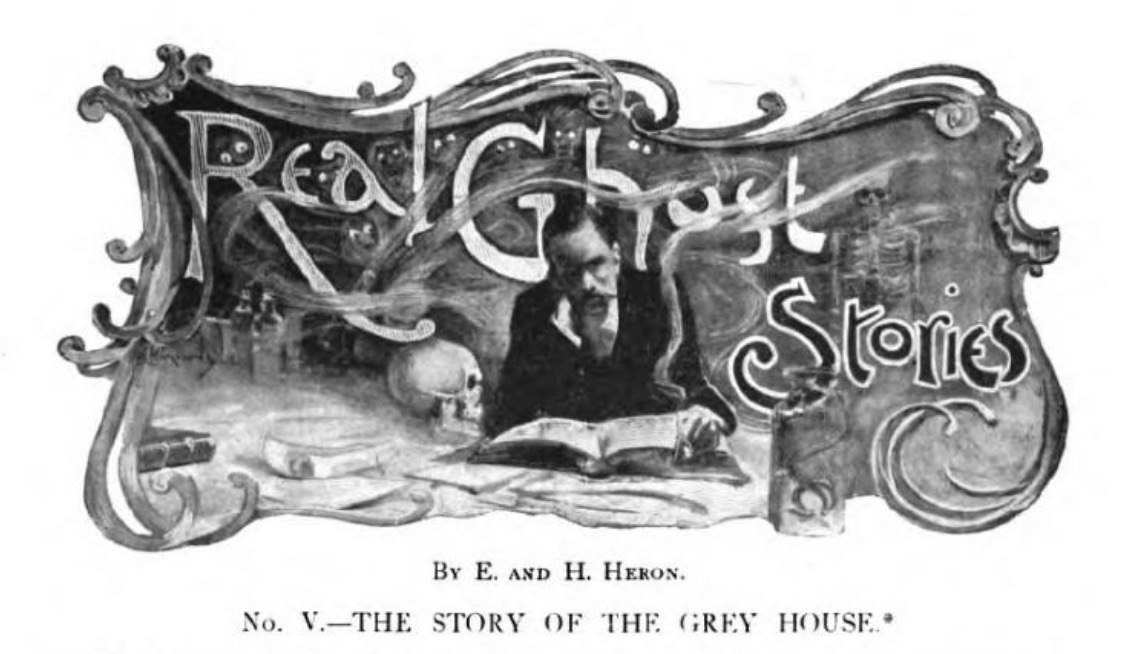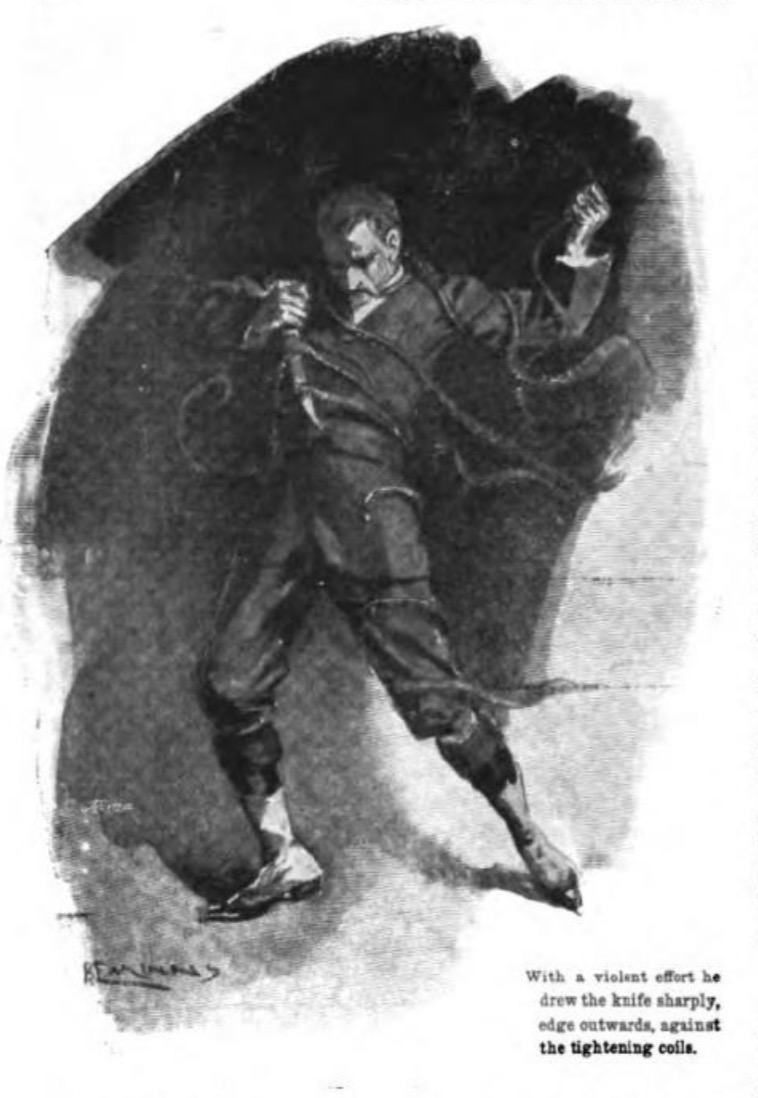THE STORY OF THE GREY HOUSE (5)
By:
October 16, 2024

HiLoBooks is pleased to serialize E. and H. Heron’s occult detective tale “The Story of the Grey House” (Pearson’s Magazine, 1898, so technically just before the sf genre’s Radium Age) for HILOBROW’s readers. Flaxman Low’s curiosity is piqued by the history of the Grey House, where numerous residents have been found mysteriously hanged… even though no rope is ever found.
ALL INSTALLMENTS: 1 | 2 | 3 | 4 | 5.
He pulled down his collar. A faint bluish circle with suffused dots was drawn round his throat.
“It is some deadly species of snake,” exclaimed Fremantle.
Low sat down astride a chair thoughtfully.
“I’m sorry to disagree with both of you. But I am inclined to think it is not a snake, and, on the other hand, I fancy it has a great deal to do with what we may roughly call a ghost. The whole evidence points in only one direction.”
“You mustn’t let your prejudice in favour of psychical problems run away with your reason,” said Fremantle drily. “Has a ghost actual, palpable power?—to go further, has it blood?”
Montesson, who had been looking at his neck in the glass, turned quickly. “It’s some horrible thing in nature! Something between a snake and an octopus! What do you say to it, Low?”
Low looked up gravely.
“In spite of Fremantle’s objections, the steps from beginning to end are very clear.”

Fremantle and Montesson exchanged a glance of incredulity.
“My dear fellow, much learning has warped your mind,” said Fremantle, with an embarrassed laugh.
“First of all,” continued Low, “we know where all the deaths have occurred.”
“To speak precisely, they have all occurred in different places,” interposed Fremantle.
“True; but within a strictly limited area. The slight differences have been of material help to me. In all cases they have occurred in the vicinity of one thing.”
“The cedar!” cried Montesson, with some excitement.
“That was my first idea—now I refer to the wall. Will you tell me the probable weight of Lawrence and Platt at the date of death?”
“Platt was a small man—perhaps under nine stone. Lawrence, though much taller, was thin, and could not have weighed more than eleven. As for poor little Fan, she was only a slip of a girl.”
“Three people have been killed—one has escaped. In what way do you differ from the others, Montesson?” asked Low.
“If you mean I’m heavier, I certainly am. I scale something like fifteen. But what has that to do with it?”
“Everything. The coils have evidently not sufficient compressive power to destroy life by strangulation simply—there must be suspension as well. You were simply too heavy for them to tackle.”
“Coils of what?”
“Of this.” Low held up a tapering, reddish-brown tendon or line, which had red-curved triangular teeth set on it at intervals.
The two other men stared at this object, and then Montesson burst out: “The creeper on the wall!” he said, in a tone of disappointment. “It couldn’t be! Besides, has a plant blood?”
“Let us go and look at it,” said Low. “This creeper has never been cut because it withers away every winter to the ground and grows again in the spring. Look here!” He took out his knife and cut a leathery shoot. A crimson stain spurted out on his cuff. “The only person, as far as I can gather, who cut this plant was Mr. Lampurt in nailing it to the wall. He died of shock when he saw the red stain on his finger, as he knew something of its deadly properties. But though stupefying— as your condition last night proved, Montesson—they are not fatal. Even to stupefy they must get into the blood. Now the deaths have all occurred within reach of the tendrils of this plant. And all have happened at the same season of the year, that is to say, at the time when it attains its full annual strength and growth. Another point in favour of Montesson’s escape was the dryness of the season. The growth is not quite so good as usual this summer, is it?”
“No; the tendrils are thinner—a good deal thinner and smaller.”
“Just so. Therefore your weight saved you, though you were stupefied by the punctures of the thorns. I feared that, and warned you to use your knife.”
“But the brain of the thing?” cried Fremantle. “Why, man, has a plant will and knowledge and malevolence?”
Not of itself, as I believe,” answered Low. “Perhaps you will prefer to attribute much to the long arm of coincidence, but the explanation I can offer is one that has for ages been held by occultists in other countries. Pythagoras and others have taught that the forms of incarnation change as the soul raises or debases itself during each spell of Life. Connect with this the belief of the Brahmins, and I may add of various African tribes, that an earthbound spirit, at the moment of a premature or sudden death, may pass into plants or trees of certain species, by virtue of an inherent attraction possessed by these plants for such entities. To go further, it is said that these degraded souls are given intervals during which they have power of voluntary action to do good or evil, and such action has influence on their future incarnations.”
“What do you mean? What do you intend us to believe?” Montesson said, and stopped.
“It is hard to put it into words in these latter days of unbelief,” said Low, “but the evidence goes to show that a man—presumably not a good man—dies a sudden death near this plant, even inoculated with its sap. Fremantle knows this plant to be a Malayan creeper, belonging to a family that possess strange powers and properties. I may recall the old story of the upas-tree, and more lately still the murder-tree discovered near Kolwe, in East Africa, by Herr Boltze. There are also other instances.”
“It is incredible!” said Fremantle almost angrily.
“I don’t ask you to believe it,” said Flaxman Low quietly, “I only tell you such beliefs exist. Montesson can do something towards proving my theory. Let him have the plant destroyed, and judge by results.”
The tendril of the creeper severed by Mr. Low in his struggle was presented by him to the authorities at Kew.
Mr. Montesson has acted upon Mr. Flaxman Low’s suggestions. The Grey House is now occupied and safe, and it is a strange fact that no plant, not even the hardy ivy, will live where the red-blossomed creeper once grew.
RADIUM AGE PROTO-SF: “Radium Age” is Josh Glenn’s name for the nascent sf genre’s c. 1900–1935 era, a period which saw the discovery of radioactivity, i.e., the revelation that matter itself is constantly in movement — a fitting metaphor for the first decades of the 20th century, during which old scientific, religious, political, and social certainties were shattered. More info here.
SERIALIZED BY HILOBOOKS: Jack London’s The Scarlet Plague | Rudyard Kipling’s With the Night Mail (and “As Easy as A.B.C.”) | Arthur Conan Doyle’s The Poison Belt | H. Rider Haggard’s When the World Shook | Edward Shanks’ The People of the Ruins | William Hope Hodgson’s The Night Land | J.D. Beresford’s Goslings | E.V. Odle’s The Clockwork Man | Cicely Hamilton’s Theodore Savage | & many others.
